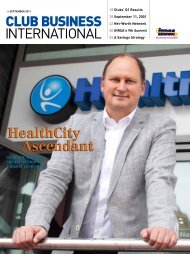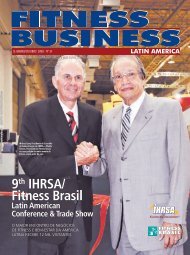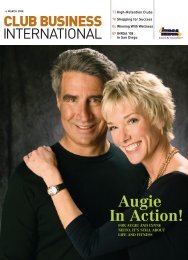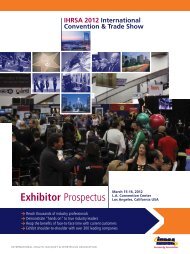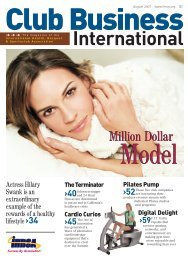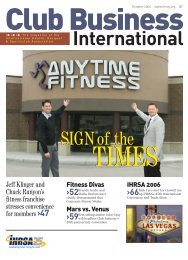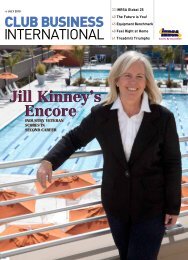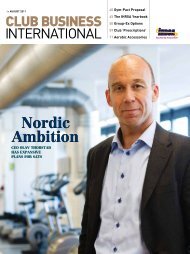Innovations - IHRSA
Innovations - IHRSA
Innovations - IHRSA
Create successful ePaper yourself
Turn your PDF publications into a flip-book with our unique Google optimized e-Paper software.
and fitness business. “GATC is the foundation for all of my<br />
club knowledge and operating experience,” he explains.<br />
“It taught me the critical importance of connecting with<br />
our members and customers; being familiar with their<br />
expectations is key to our success.<br />
“Our business is never static,” he observes. “It’s always<br />
dynamic, which is challenging, but also stimulating<br />
and exciting.”<br />
Madden’s GATC insights, as well as his instincts, would<br />
soon be put to the test.<br />
The mile-high city of Denver is, to begin with, one of the<br />
most intensely competitive fitness markets in the country,<br />
with an active, outdoors-oriented population, and a host of<br />
fine facilities to serve them. Pura Vida, conceived of as a<br />
luxury brand, was opening on the cusp of the Great Recession,<br />
when the demand for pricey products and upscale<br />
services would begin to evaporate. By some reckonings,<br />
spa industry revenues would eventually drop by 40%.<br />
“It wasn’t good timing,” Madden acknowledges. “We<br />
were opening Pura Vida just as the recession was gripping<br />
the economy with its talons.”<br />
Though it was beautiful and brand new, Pura Vida Fitness<br />
and Spa found itself in the uncomfortable position of<br />
having to reinvent itself. “We realized that our message<br />
didn’t resonate in the deteriorating economy, which, immediately,<br />
put us in the mode of having to shift, strategically,<br />
to align ourselves more closely with market conditions and<br />
consumer desires.”<br />
The principal, primary, change was to redefine the target<br />
audience. “Keith Moore, Pura Vida’s general manager,<br />
moved his sights from an older, affluent population to a<br />
younger clientele, an urban 30s and 40s crowd,” says<br />
Madden. “By doing so, he repositioned us from being<br />
exclusive to inclusive, aligned us with our market, and<br />
strengthened the substance of our brand.”<br />
The move affected every aspect of the operation,<br />
including pricing, marketing, outreach, staffing, programs,<br />
and services.<br />
The spa, originally named Nectar, was constricted most<br />
by the weight of the recession and, appearances suggest,<br />
profited most from the changes. “The original concept—<br />
pretense, fluff-and-buff, ridiculously expensive skin<br />
products and potions—didn’t work,” explains Moore. “It<br />
clearly wasn’t 2006 anymore. People were looking for<br />
something real, authentic—organic, no-fluff, serious-health,<br />
body-and-soul treatments.<br />
“The Vital Spa was born, and, immediately, the young<br />
people responded.”<br />
Today, the spa, with a staff of 20 and a director recruited<br />
from Ritz-Carlton, provides members and nonmembers with<br />
massage, manicures and pedicures, face and body treatments,<br />
and body wraps, at an average price point of $130.<br />
“The Vital Spa is the only day spa with a spa bar that allows<br />
guests to build and customize their own treatment,” Moore<br />
points out with pride. “The concept has really taken off.<br />
“You start with a basic service, let’s say deep tissue<br />
massage,” he explains, “and are then asked to customize<br />
and enhance your treatment. For instance, ‘Choose your<br />
oil: Organic Rosemary, Tuscan Lavender, Sea Kelp.’ Then,<br />
‘Choose your scalp treatment: Cranial Massage, Hot Oil<br />
Treatment, etc.’ And then there are add-ons… You can<br />
get a basic massage for $85, add a few enhancements,<br />
and still come out for under $100.”<br />
Nonmember clients also enjoy access to the rest of the<br />
club on the day they purchase services—“An incredible<br />
value,” notes Moore, as well as an effective recruiting tool.<br />
Some 23% of the club’s members make regular use of<br />
the spa. Madden, himself, books several deep tissue<br />
massages during the year.<br />
Reflecting on the realignment, Moore says, “Rather<br />
than a ‘Mangotini Massage with a Sprinkling of Gold<br />
Dust,’ the consumer was looking for a great massage, by<br />
a talented therapist, using an essential organically-based<br />
oil. Throw in a nice cup of tea, with exceptional service,<br />
attentive service<br />
in an environment that’s beautifully designed, at a price<br />
that’s under $100… and you have a busy spa.”<br />
Pura Vida Fitness and Spa, which opened with 250<br />
members, now has more than 1,500; on any given day,<br />
as many as 40% of them may utilize the club. Attrition is<br />
less than 10%. Madden, pleased with the results, and<br />
convinced that the brand has demonstrated its viability,<br />
is now eying other urban markets.<br />
“Times may be more difficult,” he says, “but people<br />
still want to take care of themselves physically, mentally,<br />
and spiritually, and that’s what our tagline, pura vida, is<br />
all about—the good life.” —|<br />
– Jean Suffin, jrsuffin@yahoo.com<br />
Wendi Schneider<br />
www.ihrsa.org | APrIL 2010 | Club Business International 33



